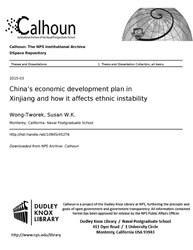File:China’s economic development plan in Xinjiang and how it affects ethnic instability (IA chinaseconomicde1094545276).pdf

Original file (1,275 × 1,650 pixels, file size: 1.12 MB, MIME type: application/pdf, 93 pages)
Captions
Captions
Summary
[edit]| China’s economic development plan in Xinjiang and how it affects ethnic instability
( |
||
|---|---|---|
| Author |
Wong-Tworek, Susan W.K. |
|
| Title |
China’s economic development plan in Xinjiang and how it affects ethnic instability |
|
| Publisher |
Monterey, California: Naval Postgraduate School |
|
| Description |
To decrease ethnic instability in Xinjiang, the Chinese government’s plan is to economically develop the region. Xinjiang is rich in natural resources, is geographically significant and has a special economic zone. China is also investing in Central Asia to further meet its energy demand. A network of pipelines and major rail systems connect sources from China to Central Asia and beyond. Xinjiang’s economy will benefit from the network because it is the gateway and corridor to Central Asia and a hub for the Silk Road traffic. This study suggests that Xinjiang’s economic development led to a few destabilizing elements, including Han migration, income disparity and employment discrimination. All of this is taking place while the government is also dealing with other cultural issues, such as religion and education. The author hypothesizes that China’s economic development plan in the Xinjiang Uyghur (or Uighur) Autonomous Region increases, decreases or is a subsidiary factor to ethnic instability. This paper argues that China’s economic development plan for Xinjiang affects ethnic stability in Xinjiang as a subsidiary factor. Subjects: China; Xinjiang; Central Asia; Uyghurs; Turkic; Hans; Silk Road; Western Development; economic; disparity; discrimination; special economic zone; infrastructure; natural resources; religion; Islam; ethnic; conflict; violence; riot; instability; migration; peace; stability; education |
|
| Language | English | |
| Publication date | March 2015 | |
| Current location |
IA Collections: navalpostgraduateschoollibrary; fedlink |
|
| Accession number |
chinaseconomicde1094545276 |
|
| Source | ||
| Permission (Reusing this file) |
This publication is a work of the U.S. Government as defined in Title 17, United States Code, Section 101. Copyright protection is not available for this work in the United States. | |
Licensing
[edit]| Public domainPublic domainfalsefalse |
This work is in the public domain in the United States because it is a work prepared by an officer or employee of the United States Government as part of that person’s official duties under the terms of Title 17, Chapter 1, Section 105 of the US Code.
Note: This only applies to original works of the Federal Government and not to the work of any individual U.S. state, territory, commonwealth, county, municipality, or any other subdivision. This template also does not apply to postage stamp designs published by the United States Postal Service since 1978. (See § 313.6(C)(1) of Compendium of U.S. Copyright Office Practices). It also does not apply to certain US coins; see The US Mint Terms of Use.
|
 | |
| This file has been identified as being free of known restrictions under copyright law, including all related and neighboring rights. | ||
https://creativecommons.org/publicdomain/mark/1.0/PDMCreative Commons Public Domain Mark 1.0falsefalse
File history
Click on a date/time to view the file as it appeared at that time.
| Date/Time | Thumbnail | Dimensions | User | Comment | |
|---|---|---|---|---|---|
| current | 15:52, 15 July 2020 |  | 1,275 × 1,650, 93 pages (1.12 MB) | Fæ (talk | contribs) | FEDLINK - United States Federal Collection chinaseconomicde1094545276 (User talk:Fæ/IA books#Fork8) (batch 1993-2020 #11287) |
You cannot overwrite this file.
File usage on Commons
The following page uses this file:
Metadata
This file contains additional information such as Exif metadata which may have been added by the digital camera, scanner, or software program used to create or digitize it. If the file has been modified from its original state, some details such as the timestamp may not fully reflect those of the original file. The timestamp is only as accurate as the clock in the camera, and it may be completely wrong.
| Short title | China’s economic development plan in Xinjiang and how it affects ethnic instability |
|---|---|
| Author | Wong-Tworek, Susan W.K. |
| Software used | Wong-Tworek, Susan W.K. |
| Conversion program | Adobe PDF Library 11.0 |
| Encrypted | no |
| Page size | 612 x 792 pts (letter) |
| Version of PDF format | 1.4 |

